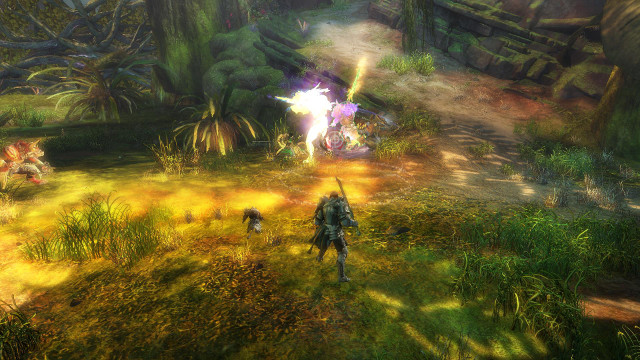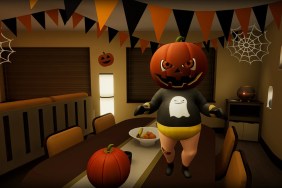Thorn in the side.
It’s been three years since Guild Wars 2 was released. It was an instant hit, delivering a beautiful, well-polished MMORPG package without a subscription fee. (In fact, I gave it a stellar 4.5/5 review.) Since then, it has been supported with free content and even made a monumental debut in China. The only thing it’s been missing is an expansion pack… until now.
For a series known for its meaningful expansions, Guild Wars 2: Heart of Thorns arrives with expectedly high hopes. It has an opportunity to rejuvenate the three-year-old landscape of Guild Wars 2, bringing back lost players, and keeping current fans invested for the months if not years to come.
Heart of Thorns has an all new storyline that features an Elder Dragon that poses a tremendous threat to the world of Tyria. You’re immediately thrust into the middle of the situation, offered a role as a leader backed by a group of similarly ambitious individuals.
Told through both in-game dialogue and the artistic splash-screens of the original game, the story is interesting and well-told by MMORPG standards. You’ll find yourself embarking on dangerous missions that, many times, end with the climax of you engaging a powerful foe. These battles include highly detailed environments and enemy models as well as interesting mechanics that incorporate the unique item system that made the original Guild Wars 2 so flavorful.
Character interactions are easy to follow with strong voice-acting performances. Unlike in many other MMORPGs, your interest is likely to be grabbed from beginning to end—a triumph in the genre.
The new zones in Heart of Thorns differentiate themselves from the rest of the world. Lush vines, sharp thorns, and dry roots border narrow corridors. Players are funneled through hazardous choke points that are guarded by a dense population of enemies. Running through them is a risk many take, only to find themselves dead and asked to spawn back at a Waypoint. Patience or power through numbers is a must.
As with the other zones in Guild Wars 2, there’s plenty to see and do in every section of the map; vistas reached by platforming, group events, Hero Point locations, and Waypoints grant you experience as you venture through these new habitats.
As you earn experience you will find yourself unlocking Masteries. These are intended to be a unique new form of progression that supplant the standard leveling model that even vanilla Guild Wars 2 utilized. You won’t find yourself growing past level 80. Instead, you will be granted access to a glider, learn how to bounce on mushrooms, and more. The glider in particular is a joy to use. Soaring through the pretty landscapes is a great way to take in the sights, in addition to being an effective means of travel. You’ll be excited to find yourself in situations where you can glide from spot to spot thanks to its intuitive input. If only the old zones supported the system.

The problem with the Mastery system is it lacks a sense of growth for your character. Instead of adhering to the MMO standard of granting you powerful abilities, equipment types, and more, you're given a physical means of passing through gated content every couple hours. At first, you’ll find that you can’t access story missions and content that you are interested in, and as you delve deeper into the mastery trees these will open up to you. You won’t find yourself excited to progress through the Mastery tree, and you certainly won’t benefit in any way that retains your interest.
Instead, Elite Specializations are what are supposed to provide a more conventional means of character progression. You’ll collect Hero Points by reaching a few hard-to-reach locations, and in most cases by battling tough foes. Once you’ve earned enough Hero Points you can begin unlocking new skills and traits.
Once again, there are issues with the design of this feature. A lot of the content that rewards Hero Points is remarkably difficult, requiring you to find a competent group. In-fact, most of the Heart of Thorns experience is designed to be completed in a group, which doesn’t work well given Guild Wars 2’s anti-social atmosphere (EDITOR'S NOTE: This is simply a note to take into consideration. It hasn't affected the final verdict of this review). Compounding this is the low reward for activity completion. Put simply, you’re going to need to invest an incredible amount of time in order to fill out your Elite Specialization tree.

There is a new profession to play called Revenant, which falls somewhere in the middle between Warrior and Guardian as it calls upon magical elements to cripple enemies while relying on melee combat to dish damage. Thematically speaking, it’s an interesting class, and its “Legendary” stance system offers a welcomed toggle between two gameplay styles. But it doesn't particularly stand out from the current roster of professions.
Perhaps the greatest shortcoming of Heart of Thorns is its entire focus on new content rather than investing in improving the foundation of the game. Sadly, Guild Wars 2 hasn’t aged well. While three years ago it received praise for being different, that simply isn’t enough in 2015 when there are more recommendable games than ever before. Its combat lacks the visual and audio feedback you find in most other AAA MMORPGs, and the ability design has you spend most of your time auto-attacking while waiting patiently for the right moment to follow up with AoE, defensive abilities, and conditions. It isn’t very fun, and the new Elite Specializations don’t do much to remedy the issue.
The Guild Wars engine is also beginning to show signs of age. On one hand the UI design is beautiful, and in most circumstances the game makes a good visual impression. However, performance on most machines is well below where it should be. The latest and greatest GPUs can limp along in the 30fps range in most environments even when settings are toned down.

So, when you begin talking about the new Heart of Thorns content, it’s difficult to remain invested in the game enough to experience it all.
In the event that you’re a fan of the game, you’ll be happy to hear that Guild Halls and Stronghold have made it into the game. These are both elements inspired by the original Guild Wars that make the game finally deliver on its name. Both are large-scale options that are sure to be favorites among players for the months to come.
In the case of Guild Halls, these function as a great place for you and guildmates to meet up and participate in group content. You can hang out in the hall with others and then gather materials to build structures. It’s a much-needed addition to the game that is already having a very positive effect on its social scene. Meanwhile, the Stronghold PvP mode is a huge addition for competitive types. It’s larger in scale than the normal PvP content, with a dose of PvE thrown in for good measure. Players looking for a more focused World-versus-World type of experience may find it to be their new favorite.

When not participating in one of these two new features, there are new Fractals and Raids to engage in. As usual, they are bizarre given the game’s aversion to dedicated healers and tanks, so as usual their ability to entertain will depend upon how much you enjoy Guild Wars 2’s combat design. Unfortunately, completing this content you will find yourself being rewarded with a lot of junk. There’s the rare occasion where you’ll find worthwhile items, but Heart of Thorns’ low number of new items makes these situations uncommon.
Heart of Thorns struggles to deliver an enjoyable experience in a variety of ways. Its lack of exciting progression coupled with an aging foundation will make it a disappointing adventure for many. Its Guild Halls and Stronghold mode help to offer new means of entertainment for returning fans, supported by a compelling story that is the expansion's greatest triumph. Guild Wars 2's first expansion is a modest addition for fans of the original, but those who haven’t found themselves captivated by it already are unlikely to walk away satisfied.
-
An interesting story with memorable battles
-
The glider is a joy to use
-
Guild Halls and Stronghold are fantastic additions
-
Lots of new content for returning players
-
New Revenant job adds more options, but doesn’t stand out
-
Hero Point acquisition has its highs and lows
-
Mastery and Elite Specialization systems are unsuccessful
-
Aging engine has surprisingly poor performance
-
Unexciting combat design has remained unchanged
-
Low quantity of new items







